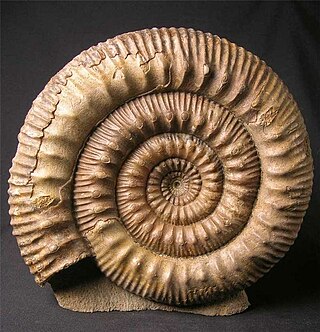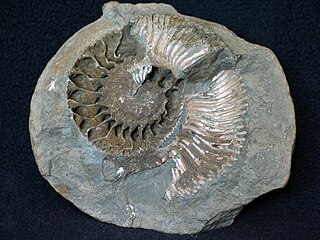
Ammonoids are a group of extinct marine mollusc animals in the subclass Ammonoidea of the class Cephalopoda. These molluscs, commonly referred to as ammonites, are more closely related to living coleoids than they are to shelled nautiloids such as the living Nautilus species. The earliest ammonites appeared during the Devonian, with the last species vanishing during or soon after the Cretaceous–Paleogene extinction event.

Euhoplites is an extinct ammonoid cephalopod from the Lower Cretaceous, characterized by strongly ribbed, more or less evolute, compressed to inflated shells with flat or concave ribs, typically with a deep narrow groove running down the middle. In some, ribs seem to zigzag between umbilical tubercles and parallel ventrolateral clavi. In others the ribs are flexuous and curve forward from the umbilical shoulder and lap onto either side of the venter.

Stephanoceras is an extinct genus of Stephanoceratoid ammonite which lived during the Bajocian. It is the type genus of the family Stephanoceratidae.
Abbasites is an extinct genus of ammonites from the early Middle Jurassic epoch, included in the ammonitid family Erycitidae.
Alcidellus is an oxyconic haploceratacean ammonite from the Middle Jurassic.

Aulacostephanus is an extinct ammonoid cephalopod genus from the Upper Jurassic Tithonian belonging to the perisphinctoidean family Aulacostephanidae.
Aspidostephanus is an extinct cephalopod genus belonging to the ammonite subclass, included in the perisphinctacean family Olcostephanidae that lived during the earliest Cretaceous and possible latest Jurassic. Fossils of the genus have been found in France, the Balearics, North Africa, and Argentina.

Ataxioceras is an extinct Ammonite cephalopod genus confined to the Upper Jurassic of Europe, included in the superfamily Perisphinctoidea.

Berriasella is a discoidal evolute perisphinctacean ammonite, and type genus for the neocomitid subfamily Berriasellinae. Its ribbing is distinct, consisting of both simple and bifurcated ribs that extend from the umbilical seam across the venter; its whorl section generally compressed, the venter more or less narrowly rounded. The species Berriasella jacobi traditionally has been regarded an index fossil defining the base of the Cretaceous, however since 2016 this had been replaced by the first occurrence of Calpionella alpina. Some authors regard B. jacobi as instead belonging to the genus Strambergella.
Duashnoceras is an extinct ammonoid cephalopod genus included in the Stephanoceratidae that lived during the Bathonian stage of the Middle Jurassic.

Garantiana is a genus of ammonites from the Bajocian stage at the beginning of the Middle Jurassic, included in the family Stephanoceratidae.
Neolissoceras is a genus of haploceratid ammonites with a smooth, compressed, flat-sided shell with a flatly rounded venter and distinct umbilical margin, from the Upper Jurassic (Tithonian) - Lower Cretaceous (Hauterivian) of southern Europe, Madagascar, and India.

Kepplerites is a moderately evolute ammonite from the lower Callovian included in the Stephanoceratoidea.
Flabellisphinctes is small, evolute ammonite genus from the upper Middle Jurassic (Callovian) that lived between 160 and 154 Ma ago.

Cardioceras is an extinct ammonite genus belonging to the family Cardioceratidae. These fast-moving nektonic carnivores lived during the Jurassic period, Oxfordian age.
Ochetoceras is a genus of ammonites, belonging to the Oppeliidae, that lived during the Late Jurassic from the early Oxfordian to the early Tithonian, and type for the subfamily Ochetoceratinae.

Lamberticeras is an extinct ammonite genus belonging to the family Cardioceratidae.

Hammatoceras is a genus of ammonites belonging to the family Hammatoceratidae which lived during the Toarcian stage of the Early/Lower Jurassic between about 184 and 175 million year ago.

Quenstedtoceras is a genus of ammonoid cephalopods that lived during the latter part of the Jurassic period in what is now France, Poland, Germany, and the United Kingdom.

Cleviceras is an extinct genus of cephalopod belonging to the family Hildoceratidae. These cephalopods existed in the Jurassic period, during Toarcian and possibly even uppermost Pliensbachian age. Sometimes, it is considered to be a synonym of Eleganticeras.













